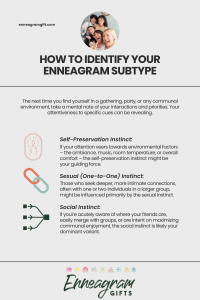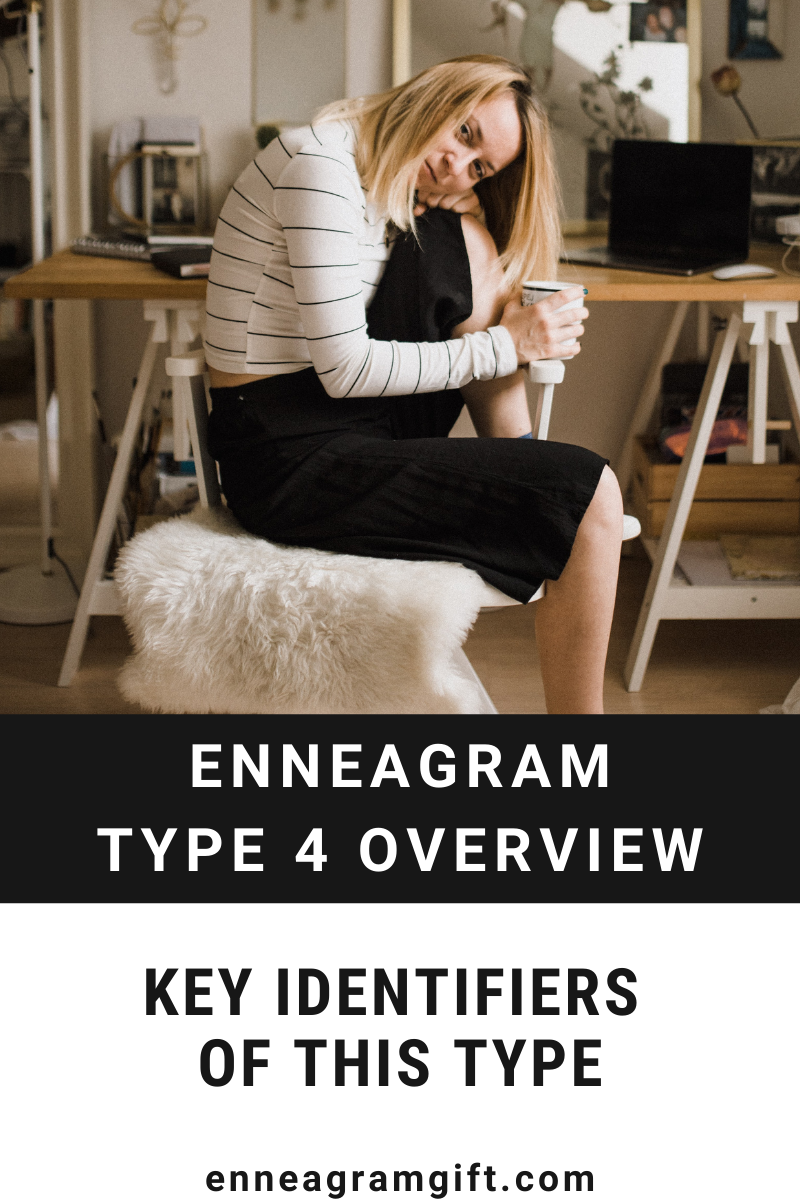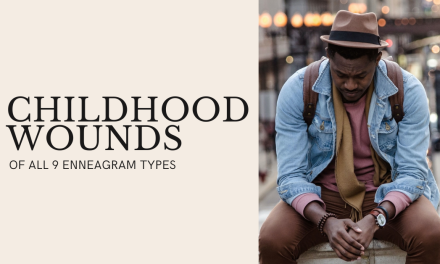The Enneagram is a powerful framework for understanding personality types and human behavior. It categorizes ways of thinking, feeling, and behaving into nine distinct personality types, each with its own core motivations, fears, and desires. These personality types offer valuable insights into how people perceive and interact with the world around them.
Yet, there’s more to this system than meets the eye. Dive deeper, and you’ll find the Enneagram Subtypes and instinctual variants. The three instinctual variants represent foundational aspects of our personalities: self-preservation, sexual, and social instincts. Depending on the scenario, each instinct can guide our behavior and reactions in distinct ways.
In the realm of personality, a medley of factors fuses to determine our interactions with the world. By grasping the Enneagram Subtypes, we pull back the curtain to reveal another dimension of each Enneagram type, uncovering how our instincts intricately influence our behaviors in various settings.
What Do Enneagram Subtypes Help Explain?
At the heart of the Enneagram lie nine distinctive personality types. Within each of these primary types nestle three subtypes, commonly referred to as instinctual variants. These three subtypes — self-preservation, sexual (often called “one-to-one”), and social — shed light on how we engage with others and navigate our environment.
A deeper dive into these Enneagram Subtypes reveals:
- Self-Preservation Instinct: This instinct illuminates how an individual values and seeks personal safety and security. It’s about self-care, comfort, and preserving well-being.
- Sexual (One-to-One) Instinct: Beyond just intimate relationships, this instinct highlights a person’s inclination towards intense one-on-one connections, closeness, and shared experiences.
- Social Instinct: This pertains to an individual’s drive for belonging within groups, understanding social hierarchies, and promoting the well-being of the collective.
Collectively, these instincts represent fundamental survival strategies, deeply ingrained in one’s modes of operation. What’s fascinating is how different individuals, even within the same Enneagram type, can exhibit unique behaviors based on their dominant subtype:
- Those led by the Self-Preservation instinct are ever-vigilant, seeking to minimize threats and ensure their needs are met.
- Social instinct-driven individuals are attuned to the ebbs and flows of communal dynamics, always mindful of their place within the group.
- People with a dominant Sexual (One-to-One) instinct place immense value on forming and maintaining strong individual bonds or pairings.
Distinguishing Between Enneagram Subtypes and Instinctual Variants
The Enneagram, while a profound tool for understanding personality, often comes with its set of terms that can be intricate to differentiate. Two such terms that frequently intertwine are “subtypes” and “instinctual variants”. Let’s delve into the distinctions between these concepts.
Instinctual Variants:
Definition: These refer to the three basic instincts that humans have for survival: self-preservation, sexual (or one-to-one), and social.
Key Points:
- Fundamental drives inherent in all humans.
- Shape our priorities and areas of focus.
- Everyone has all three, but one tends to be more dominant.
Subtypes:
Definition: The combination of one of the nine core Enneagram types with one of the three instinctual variants results in a subtype.
Key Points:
- Provides a nuanced view of each Enneagram type.
- There are 27 subtypes in total (3 instincts x 9 Enneagram types).
- Demonstrates how a dominant instinct can influence the behaviors of that type.
While sometimes used interchangeably, “subtypes” and “instinctual variants” have distinct roles within the Enneagram framework. Understanding the difference enriches our perspective of the Enneagram and its intricate layers of personality interpretation.

How To Identify Your Dominant Instinctual Variant
Every individual gravitates towards a primary instinctual variant that exerts a powerful influence over their behavior and priorities. While we may exhibit characteristics of multiple variants, there is always one dominant force paired with a core Enneagram personality type.
Discovering Your Enneagram Subtype Through Observation
A practical approach to discerning your dominant instinctual variant is to keenly observe your behavior and focus in social settings. The next time you find yourself in a gathering, party, or any communal environment, take a mental note of your interactions and priorities. Your attentiveness to specific cues can be revealing.
-
Self-Preservation Instinct (SP): If your attention veers towards environmental factors – the ambiance, music, room temperature, or overall comfort – the self-preservation instinct might be your guiding force.
-
Sexual (One-to-One) Instinct (SX): Those who seek deeper, more intimate connections, often with one or two individuals in a larger group, might be influenced primarily by the sexual instinct.
-
Social Instinct (SO): If you’re acutely aware of where your friends are, easily merge with groups, or are intent on maximizing communal enjoyment, the social instinct is likely your dominant variant.
By cultivating self-awareness and honing in on these patterns, you can get closer to understanding the instinctual drive that shapes your interactions and preferences.
It’s important to understand that each person has a dominating instinctual variant. Though we may reflect the values and behaviors of various variants or personality types, there is always one core personality type and dominating instinctual variant.
Why Your Enneagram Wing Is Not Your Subtype
A wing is based on the Enneagram’s numerical structure (the sequence from 1 to 9), and it borrows traits from adjacent types. In contrast, subtypes emerge from the intersection of your type with natural instincts. Because they derive from different sources, they can’t be interchangeable.
For instance, someone a Type 4 and a 3 wing (4w3) with a self-preservation instinct will be quite different from a 4w5 with a social instinct. The wing and subtype both influence the core type but in unique ways, making them distinct layers of personality.
While both wings and subtypes enrich the insight of your Enneagram type, they serve different purposes and arise from different aspects of the model. It’s essential to understand their distinct roles to get a comprehensive view of one’s personality within the Enneagram framework.
The 27 Enneagram Subtypes: A Chart & Overview
Diving deeper into the Enneagram reveals not just the nine foundational personality types, but also a trio of subtypes attached to each. These 27 unique combinations add depth, highlighting how our core personalities mesh with instinctual drives.
While the primary Enneagram type provides a broad understanding of one’s motivations and fears, the subtypes bring to light the nuances in our behaviors, especially in social contexts. Recognizing these patterns can guide you toward identifying your dominant subtype, offering a more tailored insight into your personality.
Below, is a chart that pairs each of the nine Enneagram types with their respective subtypes. This chart underscores the key priorities or attributes associated with each combination, making it easier to find where you resonate most:
| Enneagram Type | Self-Preservation Instinct (SP) | Social Instinct (SO) | One-to-One Instinct (SX) |
|---|---|---|---|
| Type 1: The Improver | The Safety-Seeking Pioneer Focuses on creating a safe and structured environment, pioneering efficient ways to ensure security. |
The Communal Crusader Feels responsible for improving the community, challenging and refining societal norms. |
The Idealistic Advocate Passionately promotes personal principles, expecting others to uphold these standards. |
| Type 2: The Helper | The Caring Custodian Derives self-worth from caring for close ones, seeing it as their duty. |
The Networked Diplomat Acts as a connector or diplomat within broader social networks. |
The Passionate Charmer Forms deep connections using charm, drawing others closer. |
| Type 3: The Achiever | The Corporate Climber Strives for security in structured environments, seeking visible rewards and recognition. |
The Image-Conscious Influencer Values societal acknowledgment, ensuring a polished public image. |
The Alluring Icon Emphasizes allure and charm, captivating others with magnetism. |
| Type 4: The Individualist | The Artistic Maverick Uses creativity to shield from external threats, celebrating their unique identity. |
The Authenticity Advocate Struggles with societal norms, oscillating between shame and the pride of authenticity. |
The Soulful Competitor Seeks depth in relationships, often with a dramatic or competitive flair. |
| Type 5: The Observer | The Fortress Mind Considers personal space a refuge, fortifying with knowledge and introspection. |
The Conceptual Scholar Engages socially through shared concepts, ideas, or knowledge. |
The Enigmatic Confidant Forms bonds over shared secrets or specialized knowledge, maintaining an air of mystery. |
| Type 6: The Loyalist | The Comfort Guardian Finds solace in predictable relationships, especially family bonds. |
The Civic Defender Upholds community values, often safeguarding societal norms. |
The Protective Partner Values strength and security in personal relationships. |
| Type 7: The Visionary | The Sensory Connoisseur Savors life’s experiences, seeking varied pleasures and delights. |
The Visionary Dreamer Chases idealistic visions of society, often with personal sacrifices. |
The Curious Explorer Drawn to new experiences and relationships, captivated by fascination. |
| Type 8: The Challenger | The Resilient Maverick Stands independent, thriving in challenges and asserting dominance. |
The Cause Champion Leads and fights for social causes or justice, demanding respect. |
The Intense Devotee Engages in relationships with deep intensity, either dominating or surrendering fully. |
| Type 9: The Peacemaker | The Serene Collector Finds comfort in collecting or savoring memories and experiences. |
The Harmonious Contributor Participates in communities, often as a peacekeeper or helper. |
The Unifying Partner Seeks deep unity in relationships, blending their identity with their partner’s. |
Enneagram 1 Subtype Descriptions
Enneagram 1 Instinctual Variants:
Self-Preservation: The Safety-Seeking Pioneer
Self-Preservation Type 1s embody the relentless quest for a flawless environment. Viewing themselves as deeply imperfect, they strive to refine every aspect of their lives. Their heightened sense of caution makes them extraordinarily detail-oriented, always prepared and planning for contingencies. While they internalize their anger, disruptions to their meticulous plans can trigger deep-seated frustration.
Social: The Communal Crusader
Embracing a well-defined social role, Social Type 1s take pride in doing things “by the book.” Their dedication to societal standards can lead to rigidity, making adaptability a challenge. They may become critical of those who deviate from the norm, viewing themselves as guides steering others towards “correct” behavior.
One-to-One: The Idealistic Advocate
These Type 1s exhibit intense self-discipline, occasionally bordering on zealousness. Their desire for unwavering attention from a partner stems from a fear of personal inadequacy. They relish clearly defined behavioral standards, and their inherent jealousy often arises when others appear more liberated or self-assured. Their passion projects outwards more than other Type 1s, with a keen focus on elevating others to meet their high standards.
Enneagram 2 Subtype Descriptions
Enneagram 2 Instinctual Variants:
Self-preservation: The Personal Ally
The Self-preservation Type 2 shines in cultivating intimate and heartwarming relationships. They’re naturally inclined to nurture, support, and be there for others. While their intentions are pure, there’s an underlying belief that they have a special entitlement when it comes to their needs. This can occasionally manifest as a subtle form of pride or even a guise of humility.
Social: The Networked Diplomat
Social Type 2s derive their self-worth from their achievements and the validation of the collective. Their heightened sense of empathy and attunement to others’ needs makes them invaluable in group settings. Rather than desiring the spotlight, they prioritize building alliances with influential figures, ensuring they’re strategically connected within their social landscape.
One-to-One: The Intimate Charmer
These Type 2s excel at interpersonal dynamics, deploying their innate ability to connect deeply with chosen individuals. Their subtle cues, be it in speech or body language, have a mesmerizing quality. While this isn’t always romantically motivated, it carries a magnetic pull. In its intense form, this subtype yearns for undivided attention, seeking recognition and affirmation from their close circle.

Enneagram 3 Subtype Descriptions
Enneagram 3 Instinctual Variants:
Self-preservation: The Enterprising Achiever
The Self-preservation Type 3 embodies the spirit of relentless drive and ambition. Their eyes are set on tangible milestones: the perfect house, a secure financial foundation, and an enviable career. Their pursuit of material success is unyielding. Yet, there’s a cautionary tale here: in their zealous bid to excel at their professional roles, they risk disconnecting from their authentic selves.
Social: The Visionary Strategist
For the Social Type 3, success is as much about the journey as it is about the accolades. Their arena is the complex world of societal dynamics. With an innate ability to network, they aim to rub shoulders with influential figures and make strategic inroads into prominent circles. Their leadership, whether genuine or curated for public perception, revolves around sculpting an impeccable image. They’re tacticians of social navigation, always cognizant of their public persona.
One-to-One: The Alluring Magnet
Radiating charisma, the One-to-One Type 3 is acutely aware of the power that lies in personal appeal. Their image is meticulously crafted to resonate with what’s deemed attractive, playing into societal archetypes of masculinity or femininity. Regardless of the setting – be it intimate settings or grand stages – they remain the performer, weaving a magnetic aura that’s hard to resist. They epitomize the blend of charm and allure that captivates an audience.
Enneagram 4 Subtype Descriptions
Enneagram 4 Instinctual Variants:
Self-preservation: The Artistic Maverick
The Self-preservation Type 4 dances on the edge between desiring material comforts and questioning their true significance. Their life’s rhythm often beats to a different drum. Brimming with dauntless energy, they unhesitatingly dive into new ventures, chase uncharted paths, and embrace risks. Their decisions might seem impulsive or whimsical to onlookers, but for them, it’s a symphony of creativity and fearless individualism.
Social: The Cultural Critique
For the Social Type 4, society’s theater is a double-edged sword. On one side, they grapple with feelings of inadequacy, often casting envious glances at those who seem to naturally fit in or command respect. On the flip side, there’s a yearning to bridge the chasm between societal norms and their authentic self. Navigating this dynamic tension, they search for a role that lets them both belong and remain true to their essence, often emerging as insightful commentators on the cultural milieu.
One-to-One: The Passionate Challenger
To the One-to-One Type 4, life is a vibrant tapestry of challenges and rivalries. They thrive on competition, using it as fuel to quash inner doubts and propel themselves forward. Their keen eyes are always assessing, measuring their ideals against those they perceive as potential competitors. This competitive streak is both their motivation and their muse, as they oscillate between moments of self-assessment and striving for excellence.
Enneagram 5 Subtype Descriptions
Enneagram 5 Instinctual Variants:
Self-preservation: The Fortress Architect
For the Self-preservation type 5, their abode is not just a home – it’s a fortress. Steeped in a sense of sanctuary, every brick and stone embodies their need for safety and seclusion. They are the stewards of their sanctum, vigilantly ensuring its defenses are impregnable and its supplies inexhaustible. The world outside might be unpredictable, but within their walls, they command every element. They have mastered the art of creating borders, judiciously deciding who may enter their sacred space and when they themselves need to retreat from the world.
Social: The Scholarly Maven
A social 5 embodies the essence of intellectual pursuit. Every book, every theory, every symbol is a beacon drawing them into the depths of knowledge. These erudite explorers dive deep into their chosen realms, emerging not just as learners but as luminaries. Their fervor for understanding often sees them congregating with fellow aficionados, establishing a camaraderie based on shared expertise. However, their analytical nature, sometimes, might erect barriers of over-intellectualization, momentarily disconnecting them from the experiential world.
One-to-One: The Enigmatic Confidant
Delving deep into the psyche’s labyrinth, the One-to-One type 5 navigates the delicate balance between intimacy and independence. With an air of mystique, they curate which truths they unveil and to whom. Relationships become sanctified chambers of trust, where they cautiously extend the olive branch of their innermost thoughts and emotions. Though they might appear inscrutable to the outer world, in private one-on-one interactions, they reveal the rich tapestry of their feelings, all the while cherishing the sanctity of the bond they form.

Enneagram 6 Subtype Descriptions
Enneagram 6 Instinctual Variants:
Self-preservation: Warmth – The Comfort Guardian
The Comfort Guardian of Type 6 finds immense comfort in the predictability of relationships, especially those stemming from familial bonds. The safety and assurance derived from these ties act as a buffer against their inherent anxieties. Driven by a quest for security, they tend to gravitate towards situations and people that offer a consistent and dependable presence. Their world is one where trust is built over time, with each predictable interaction reinforcing their sense of safety.
Social: Duty – The Civic Defender
Championing the cause of community values and societal norms, the Civic Defender stands as a pillar upholding the traditions and norms of their environment. This Type 6 feels a profound duty to preserve the integrity of their community, driven by a desire for stability and a clear societal structure. Doubt may creep in at times, making them question their place within the collective, but their steadfast commitment to duty provides a grounding force, guiding their actions and decisions.
One-to-One: Strength – The Protective Partner
For the Protective Partner subtype of Type 6, strength and security reign supreme, especially within personal relationships. They wear their protective nature like armor, ready to defend their loved ones against any perceived threats. Their relationships are built on a foundation of mutual trust and resilience. While they may grapple with their own fears and insecurities, their unwavering dedication to the safety of their partners serves as both their motivation and anchor.
Enneagram 7 Subtype Descriptions
Enneagram 7 Instinctual Variants:
Self-preservation: The Sensory Connoisseur
A self preservation type 7 takes a moment to inhale the aromas, to let every flavor linger on their palate, and to truly immerse themselves in the sensory delights of life. They are like connoisseurs at a tasting, eagerly seeking out the richest experiences that life has to offer. From the euphonious melodies of music to the tantalizing tastes of gourmet foods, they revel in it all. Family gatherings, friendly get-togethers, or solo adventures — each becomes a curated experience. Their mantra revolves around embracing the now and extracting every ounce of pleasure from it.
Social: The Visionary Dreamer
Driven by a profound desire to weave a tapestry of communal harmony, the Visionary Dreamer of Type 7 isn’t just content dreaming — they act on it. With an idealistic vision in tow, they are unafraid of making sacrifices, understanding that sometimes personal desires must be curtailed for the collective good. This subtype sees a world brimming with potential and works towards turning this potential into tangible societal betterment. The juxtaposition of their intrinsic Type 7 optimism with their willingness to make sacrifices makes them a force to be reckoned with in any community-driven mission.
One-to-One: The Curious Explorer
The Curious Explorer is perpetually on the verge of a new discovery. Every day dawns with the promise of a novel experience, a fresh insight, or a previously unexplored relationship. Their fascination is contagious, pulling in those around them into their whirlwind of excitement. They view life through the lens of endless possibilities and are not just passive observers but active participants, keen on diving deep into the heart of every experience. With an insatiable curiosity driving them forward, they are the adventurers of the Enneagram, forever eager to see what lies beyond the horizon.
Enneagram 8 Subtypes
Enneagram 8 Instinctual Variants:
Self-preservation: The Resilient Maverick
The Resilient Maverick of Type 8 stands tall, unfazed by challenges. Like a formidable fortress, they exude an aura of indomitability, always prepared to rise to the occasion. This subtype takes pride in their ability to navigate the tempests of life, all while asserting their dominance and ensuring the well-being of their loved ones. For them, every challenge is an opportunity — a chance to prove their resilience and mettle. They thrive under pressure, and their determination is, more often than not, the stuff of legends.
Social: The Cause Champion
When a cause beckons, the Cause Champion of Type 8 is at the forefront, leading the charge with fervor and gusto. Their innate leadership skills combined with a burning passion for justice make them formidable advocates for societal change. They command respect, not merely for their assertiveness, but for their unwavering commitment to the greater good. While they might wear a tough exterior, their dedication to their friends and the causes they champion is testament to a heart that beats with intense loyalty and empathy.
One-to-One: The Intense Devotee
In the world of relationships, the Intense Devotee of Type 8 experiences everything in high-definition. Every emotion is felt profoundly, every connection is either dominated or surrendered to, with little room for in-between. Their relationships are characterized by a deep intensity, wherein they seek either to possess or to completely give in. This subtype often finds themselves oscillating between wanting control and being willing to let go, driven by their deep and passionate nature. Their relationships are seldom tepid; they’re always a fervent dance of power and vulnerability.

Enneagram 9 Subtypes
Enneagram 9 Instinctual Variants:
Self-preservation: The Serene Collector
The Serene Collector revels in the art of collecting experiences and memories. Their life’s tapestry is adorned with moments that bring them comfort and evoke a sense of nostalgia. For them, life is not about the rush but the calm spaces in between. While they deeply cherish material comforts, they also have a penchant for savoring life’s little joys, often chronicling them in some way. They must, however, be wary of using these collections as a distraction from their deeper, individual needs and aspirations.
Social: The Harmonious Contributor
A beacon of peace and harmony in their communities, the Harmonious Contributor wears their role as the group’s balancer with pride. They immerse themselves in communal activities, constantly seeking a sense of belonging and purpose. Their intrinsic desire to be a part of something bigger often makes them the unsung heroes in group settings. Their gentle and selfless nature, combined with their uncanny ability to blend seamlessly with any group, often propels them to leadership roles. However, they should remain vigilant not to sideline their personal needs in the pursuit of community welfare.
One-to-One: The Unifying Partner
Relationships for the Unifying Partner are a dance of identities. They seek connections so profound that the boundaries between ‘me’ and ‘you’ often blur. With a heart full of love, they tend to meld with their partners, sometimes to the point of losing their individual essence. Their innate sweetness and gentleness make them incredibly endearing, but this also makes them susceptible to adopting their partner’s desires and beliefs as their own. It’s essential for them to occasionally step back, introspect, and re-establish their unique identity within their relationships.
10 Ways To Use Subtypes For Personal Development
These subtypes offer a nuanced lens through which we can view our motivations, fears, and behaviors. Delving into this understanding can catalyze profound personal growth.
-
Enhanced Self-awareness: Recognizing your subtype can provide deeper insights into your behavior, motivations, fears, and desires. With this self-awareness, you can make more informed decisions and better understand your reactions to different situations.
-
Identifying Blind Spots: Every subtype has its strengths and challenges. By understanding your subtype, you can become aware of potential blind spots or areas of neglect in your life, whether they are in relationships, work, or personal growth.
-
Relationship Understanding: Recognizing the subtypes of people around you can help you better understand their motivations and reactions. This can lead to improved communication, empathy, and reduced conflicts in personal and professional relationships.
-
Personal Growth Strategy: With the knowledge of your subtype, you can tailor your personal development strategies. For instance, if your subtype leans towards isolation, you might work on strategies to engage more socially.
-
Improved Stress Management: Each subtype has its way of dealing with stress. Recognizing your natural tendencies can help you develop healthier coping mechanisms.
-
Setting Boundaries: Understanding your subtype can aid in setting healthy boundaries. For instance, if you tend to merge with others’ desires and needs, recognizing this can help you establish a separate identity and prioritize self-care.
-
Career Decisions: Knowledge of your subtype can guide you in career decisions, helping you find roles that align more closely with your intrinsic motivations and strengths.
-
Deepening Spiritual Practices: For those on a spiritual journey, understanding one’s subtype can give insights into spiritual challenges and strengths, guiding practices and reflections.
-
Understanding Addictions and Dependencies: Subtypes can shed light on potential areas of dependency, whether it’s a dependency on relationships, work, or substances. This understanding can be the first step towards seeking help or modifying behavior.
-
Goal Setting: Recognizing your subtype’s intrinsic motivations can help in setting goals that are genuinely fulfilling and aligned with your inner self.
The journey of self-awareness and personal growth is an evolving one. By integrating the profound insights offered by the Enneagram subtypes, we can navigate this journey with greater clarity and purpose. Whether you’re looking to enhance your relationships, refine your career choices, or deepen your daily rhythms, the Enneagram is a helpful resource.
You will also enjoy the following posts:
Understanding Enneagram Stances | How It Influences Your Interactions With Others
The 3 Enneagram Triads + Advice For Responding To Emotions For Each Type




